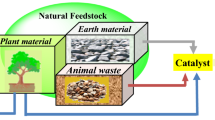Abstract
In this book, several recent developments for the usage of renewables with homogeneous catalysis are presented. At the present stage of development, classic homogeneous catalysed reactions, such as hydrogenation, metathesis, hydroformylation, telomerisation, aminations, or oxidations, play a key role.
Access provided by CONRICYT-eBooks. Download chapter PDF
Similar content being viewed by others
Keywords
These keywords were added by machine and not by the authors. This process is experimental and the keywords may be updated as the learning algorithm improves.
In this book, several recent developments for the usage of renewables with homogeneous catalysis are presented. At the present stage of development, classic homogeneous catalysed reactions, such as hydrogenation, metathesis, hydroformylation, telomerisation, aminations, or oxidations, play a key role.
Specially, the hydrogenation of CO2 for energy storage is an emerging field and is promising especially if it comes to rechargeable systems. Hydrogenations are further a tool to tailor-made product mixtures from crude renewable polymers like celluloses or lignin. The topic of cracking the natural polymers to smaller platform molecules will be a field in the future where homogeneous catalysis can give high regioselectivity towards certain bond cleavage in, e.g., lignin. Therefore, further developments for more tolerant catalyst against impurities and the recycling or separation of the catalyst are of high need.
Also, in the work-up of crude renewable mixtures, the oxidation is a very potent tool to generate small intermediates. This field is not so far developed than the hydrogenation, so new ideas on catalyst systems with high selectivities will play a role for this reaction and if these conversions will be applied in bigger scales. Furthermore, oxidation of fatty compounds delivers today industrially monomers and other everyday chemicals. The development of catalysed processes to get rid of the energy-intensive ozonolysis is still ongoing. Here, the development of recycling techniques for the homogeneous catalyst is crucial for future applications. The oxidation with homogenous catalysis is a tool in the fine chemistry with, e.g., terpenes to yield very valuable products from renewable feedstocks.
Telomerisation, aminations, and hydroformylation are reactions to give renewables new or other functionalities. Telomerisations need conjugated double bonds, aminations a double bond or an alcohol moiety, and the hydroformylation a double bond to high value products. Telomerisations give a straightforward reaction to incorporate renewable nucleophiles or renewable terpenes which contain a conjugated double bond. The scope of the reaction with renewables is by far not explored, so there is room for new surfactants, or monomers by this reaction. The same is true for aminations, in which several renewable amines or renewable alcohols will play a role in the future. Hydroformylation is a very versatile reaction to yield aldehydes which are then intermediate, for example alcohols and amines. Fatty compounds or terpenes yield very interesting molecules for several intermediates. Therefore, we will see new applications of these reactions in future.
Hydroformylation is also a key step in several tandem reactions with renewables, besides isomerization, metathesis, and decomposition reactions. The merger of several reactions to convert renewables is very beneficial because no intermediate work-up is necessary to perform a variety of reaction steps to tailor-made products. So isomerization and metathesis of unsaturated fatty compounds can form a broad mixture of unsaturated fatty acids, alkenes, and diacids. Also, decomposition of, e.g., glycerol to syngas and their use in hydroformylation are a nice example where homogeneous catalysis can guide new directions. The isomerization and carbonylations of fatty acids are clearly one hot topic of the tandem reaction development over the last years and form directly from renewables monomers. These cases show the potential of tandem reactions, and more creative mergers of homogenous catalyst will be seen in the future.
All shown reactions of renewables catalysed by homogenous catalyst can only become economic if the precious catalyst can be separated or in the best case recycled. In this book, several recycle strategies are shown such as ionic liquids, supercritical CO2, and thermomorphic systems. These approaches are the key to apply these techniques in a bigger scale. Therefore, miniplant or pilot plants are important to test the long-term stability of catalysts. In terms of stability operation times of several hundred to several thousand hours are indicators that processes can be run stable and are economical feasible. In particular, these aspects are under-represented in the today’s academic research. Not only with renewables mechanisms for ligand degradation are unknown, so very nice transformations of substrates are at this stage just feasible for one batch reaction. In situ spectroscopy can give more information of the degradation mechanisms and has a big potential to enhance homogenously catalysed reactions.
To sum up, this book give an overview on homogeneously catalysed key reactions with renewables. A lot of reactions have been studied, but there is a big potential to find new substrates of the existing reactions or find new mergers of reactions. The development of the existing reactions to scalable processes and a combined recycling of the homogeneous catalyst are still an underestimated challenge that should be focused on future development more firmly.
Author information
Authors and Affiliations
Corresponding author
Rights and permissions
Copyright information
© 2017 Springer International Publishing AG
About this chapter
Cite this chapter
Behr, A., Vorholt, A.J. (2017). Future Developments in Homogenous Catalysis with Renewables. In: Homogeneous Catalysis with Renewables. Catalysis by Metal Complexes, vol 39. Springer, Cham. https://doi.org/10.1007/978-3-319-54161-7_12
Download citation
DOI: https://doi.org/10.1007/978-3-319-54161-7_12
Published:
Publisher Name: Springer, Cham
Print ISBN: 978-3-319-54159-4
Online ISBN: 978-3-319-54161-7
eBook Packages: Chemistry and Materials ScienceChemistry and Material Science (R0)




